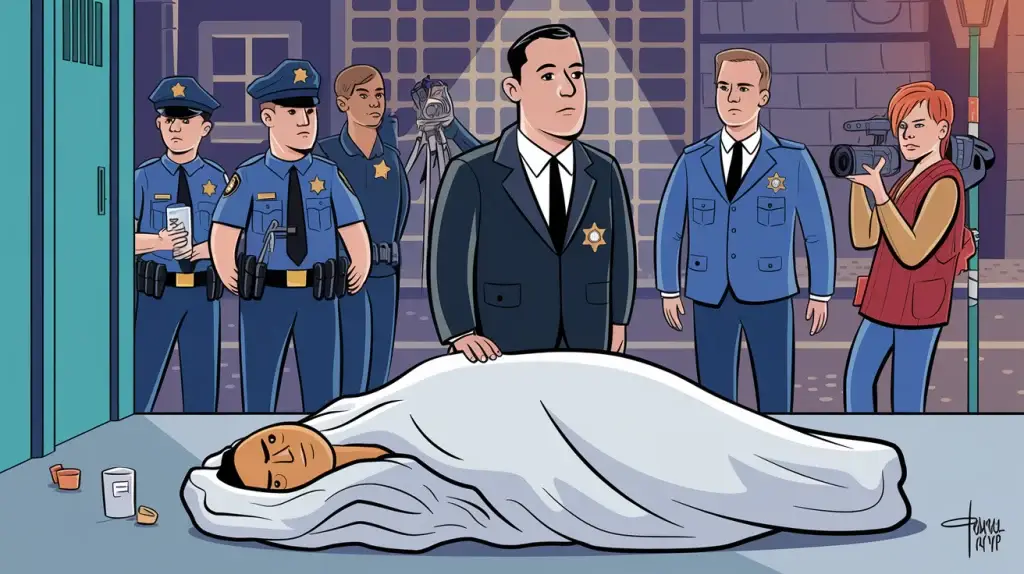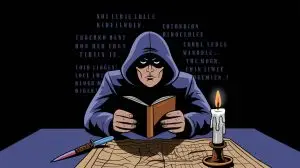The Black Dahlia murder Investigations remains one of the most chilling and enigmatic cases in American history.
The story unfolded on January 15, 1947, when the body of 22-year-old Elizabeth Short was found in Los Angeles. Her case drew media frenzy because of the horrific details—Short’s body was found cut in half, with a haunting smile carved into her face.

Back then, the investigation saw a deluge of confessions—more than thirty people claimed responsibility for the crime, though most were dismissed as false. This high-profile case put the pressure on detectives to sift through each lead meticulously. The FBI even got involved, assisting the Los Angeles Police Department, but no definitive suspect was ever charged. Among those considered during the investigation was George Hodel, whose name emerged in late 1949, adding another layer of intrigue.
Even today, the Black Dahlia case intrigues true crime fans and amateur detectives. With its combination of Hollywood glamour and gruesome crime details, the mystery surrounding Elizabeth Short’s murder continues to spark interest and speculation, ensuring the case remains in the public eye.
Elizabeth Short: A Tragic Figure
Elizabeth Short’s life was a mix of dreams and uncertainty. She sought fame in Hollywood but faced many struggles. Delve into her early years and time in Los Angeles to understand her journey.
Early Life and Aspirations
Born in 1924, Elizabeth Short grew up in Massachusetts. Her childhood was marked by her parents’ separation, adding challenges to her early years. She had a keen interest in acting, a passion that would lead her to Hollywood.
At just 19, Elizabeth moved to California. Her dreams revolved around becoming a star. The bright lights of Hollywood Boulevard were calling. Despite her aspirations, life was tough. Supporting herself wasn’t easy, and work was scarce. Yet, her determination didn’t wane.
Family and friends often spoke of her charm and grace. She believed that her big break was just around the corner. Her journey, however, was abruptly interrupted.
Final Days in Los Angeles
In January 1947, Elizabeth Short’s life was tragically cut short. She was last seen at the Biltmore Hotel in downtown Los Angeles. That evening, she was planning to meet her sister. Unfortunately, she never made it.
Elizabeth’s murder shocked the nation. Her body was found in a gruesome state, and the case remains unsolved to this day. The media dubbed her the “Black Dahlia,” a name that became infamous. Despite intense investigations, the mystery of her death continues to capture public attention.
Her dreams unfulfilled, Elizabeth Short remains a haunting figure in Hollywood history. Though she never achieved fame in life, her story and the enigma surrounding it persist.
Overview of the Murder
The Black Dahlia murder shocked Los Angeles in the late 1940s. Elizabeth Short, an aspiring actress, met a tragic fate, resulting in a complex, unsolved case that haunts the city to this day.
Discovery of the Crime
On the morning of January 15, 1947, a woman named Betty Bersinger was taking a walk through Leimert Park when she stumbled upon a chilling sight. At first, she thought she saw a broken mannequin. As she got closer, she realized it was a young woman’s body, split in half and severely mutilated. This brutal discovery launched what became known as the Black Dahlia case, due to Elizabeth Short’s dark hair and wardrobe.
Police quickly arrived at the scene, drawn by the gruesome nature of the crime. The body was positioned with precision, adding a haunting element to the investigation. Detectives faced a challenging task ahead as the public’s fear grew. This notorious crime scene drew media frenzy and national attention, impacting how crime was reported in the future.
Grisly Details of the Case
Elizabeth Short’s autopsy revealed some disturbing facts. She suffered a grotesque mutilation known as the “Glasgow smile,” where cuts extended from her mouth towards her ears. The killer’s careful method showed a troubling level of precision. Further examination found that her body had been drained of blood, cleaned, and manipulated with, suggesting someone with medical knowledge was involved.
The crime sent shivers down the spines of even the most seasoned detectives. Over time, more than 150 suspects were considered, but the case remains unsolved. The mysterious nature and lack of closure continue to fuel fascination and countless theories about what truly happened to Elizabeth Short.
The Investigation

The Black Dahlia case was a complex and challenging murder investigation. The Los Angeles Police Department faced many obstacles in solving this gruesome crime. They tackled initial challenges, examined key evidence, and focused on several suspects, including some intriguing personalities.
Initial Steps and Challenges
The investigation kicked off with the discovery of Elizabeth Short’s body on January 15, 1947, in Los Angeles. From the start, the LAPD dealt with significant challenges. The crime scene was contaminated by onlookers and the media. The 1940s lacked advanced forensic technology, making it tough to gather evidence.
The case caught public attention, increasing pressure on the LAPD. They collaborated with the FBI, who managed to identify the victim as Elizabeth Short using her fingerprints. The high-profile nature of the case meant that detectives experienced public scrutiny, requiring them to maintain a careful balance between sharing information and maintaining confidentiality.
Key Evidence Collected
Despite the chaotic start, investigators gathered crucial evidence. Notably, Elizabeth Short’s body was found mutilated, which guided detectives in understanding the severity of the crime. Some evidence included a trail of personal items left nearby. The Black Dahlia Avenger, as the killer was dubbed, also sent letters to the Los Angeles Examiner, piquing both curiosity and fear.
Fingerprint evidence was a key component, utilized by the LAPD in an attempt to find matches. Despite these efforts, no solid breakthrough was achieved. The complexity of the crime scene presented difficulty; however, these pieces laid the groundwork for future investigation methods and public engagement strategies.
Notable Suspects
Over the years, several suspects emerged, each with their own story. Notably, George Hodel, a Los Angeles doctor, became a primary focus. He was linked to the crime through accusations made by his daughter, Tamar. Another suspect was Leslie Dillon, a bellhop and writer, whose knowledge of the case sparked interest among detectives.
Steve Hodel, George’s son, later penned a book accusing his father of the murder, reigniting public interest decades later. These suspects each presented fascinating angles, yet the LAPD struggled to gather enough evidence to convict anyone. The case remains one of Hollywood’s most famous unsolved mysteries.
Media and Public Fascination

The Black Dahlia case grabbed headlines and public attention with its shocking details. The media went into a frenzy, focusing on the unsolved murder of Elizabeth Short. Hollywood added fuel to the fire, turning the case into an endless source of fascination.
Press Coverage
The murder of Elizabeth Short, known as the Black Dahlia, quickly became a media sensation. Newspapers plastered her face everywhere, and reporters flocked to Los Angeles. The press was desperate to uncover any detail of her life or the case. At times, it felt like a race to outdo each other in uncovering the most intriguing or scandalous aspect. The media circus sensationalized every twist and turn, ensuring no stone was left unturned. One tool used was the Soundphoto, a new technology that allowed photos to be transmitted quickly, adding images to the shocking headlines.
Hollywood’s Influence
Hollywood couldn’t resist the magnetic pull of such a dramatic story. The idea of a Hollywood starlet caught the imagination of filmmakers and writers. Orson Welles was even dragged into the speculation, showing how deeply the case embedded itself in Hollywood. While no direct connection to the glitter of Hollywood was ever proven, whispers and rumors persisted. The case inspired writers like James Ellroy, who fictionalized it, adding another layer to its mystery. Movies and documentaries followed, keeping the story alive in the entertainment world.
Legacy in Popular Culture
The Black Dahlia case left a lasting mark on popular culture. From movies to novels, its influence can be seen. It sparked endless theories and discussions, with some adding bizarre twists. The mystery was furthered by the mysterious anonymous letter sent to the police, which added to the chilling atmosphere. True crime enthusiasts and amateur detectives continue to be drawn to the grisly details and unsolved mystery. This persistent fascination highlights the story’s impact and the lingering questions about who Elizabeth Short was and what really happened to her.
Legal Proceedings and FOIA

In the years since the Black Dahlia murder, investigators have combed through countless leads but never solved the case. The quest for justice has seen a mix of legal proceedings and the use of open records.
Documented Evidence
Legal proceedings on the Black Dahlia case involved detailed examination of various types of evidence. Case files were thoroughly analyzed to identify any potential leads. Although a mug shot or suspect line-up was never publicly endorsed, investigative agencies collected numerous witness testimonies and photographs to aid in their inquiry.
The handling of evidence sometimes sparked public curiosity, as some believed more could be revealed. This back-and-forth exchange between detectives and the media only heightened with time. Despite relentless efforts, concrete evidence has remained elusive in solving this notorious unsolved murder. The challenge persists as archived records get periodically reviewed by true crime enthusiasts and investigators alike.
Freedom of Information Acts’ Role
The Freedom of Information Act (FOIA) played a significant part in revealing classified documents regarding the Black Dahlia investigation. With the help of this Act, concerned citizens and journalists have accessed case files that were once sealed. These files shed light on the inner workings of the investigation, bringing both clarity and more questions to the forefront.
FOIA requests have provided a closer look at these old records, supporting the hopes of new breakthroughs. As the case remains unsolved, FOIA continues to serve as a crucial tool for those seeking to revisit the mystery. While this legislative act peels back some mystery layers, it reminds us of justice yet to be served.
Cultural and Historical Context

The Black Dahlia murder unfolded in a time when Los Angeles was bustling with post-war activity. The city was grappling with social changes as soldiers returned home and women navigated new roles.
These dynamics created a backdrop filled with excitement as well as challenges.
Los Angeles in the 1940s
Los Angeles in the 1940s was a city of contrasts. Hollywood was thriving, filled with star-studded glamour, but not everyone was living a red-carpet life.
The city’s population was booming. Many were drawn by the lure of sunshine and opportunity. Yet, beneath the sparkle, social challenges were emerging, like underage drinking, a concern in many neighborhoods.
Nightclubs and bars were lively, catering to a mix of aspiring actors and everyday folks. Music and films blossomed, shaping pop culture. However, the growing city also saw rising crime rates.
The police force struggled to keep up, which added layers of complexity to investigations like the Black Dahlia case. In such a large and fast-paced city, the murder got noticed, capturing everyone’s attention.
The Aftermath of the War
After World War II, Los Angeles adapted to big changes. Many servicemen returned from places like Camp Cooke, near Santa Barbara, seeking new beginnings. This influx shifted the city’s dynamics, affecting jobs and housing.
Women who had worked while men were at war faced new roles, sparking societal shifts. Industries expanded, contributing to economic growth but also major adjustments.
The mix of celebration and readjustment left a mark, shaping the cultural vibe of the city.
Movies mirrored these changes, providing stories and entertainment that resonated with a diverse audience trying to find a sense of normalcy in the post-war world. This atmosphere lingered, creating a rich, complex setting that influenced life in Los Angeles during this period.
Personal Tragedies and Stories
The Black Dahlia case was not only a crime story but also a tapestry of personal heartbreaks and connections. Many people were affected by Elizabeth Short’s life and tragic death.
Elizabeth’s Personal Connections
Elizabeth Short, often seen on the glamorous streets of Hollywood, had a complex personal life. Her connections ranged from family to former flames.
One significant figure was Major Matthew Michael Gordon Jr., a decorated war hero, who claimed to have proposed to her. Their relationship was marked by letters exchanged while he was stationed overseas. Sadly, he died in a plane crash before they could reunite.
Elizabeth also lived in several places, including Vallejo, known for the bustling Mare Island Naval Shipyard. Her stays were often short, marked by a quest for both fame and stability.
She faced personal battles, such as dealing with respiratory problems, which added an extra layer of difficulty to her life.
Affected Families and Individuals
The gruesome murder reverberated through Los Angeles, deeply affecting those tangled in the investigation.
Mark Hansen, a nightclub owner, was a person of interest due to his close ties with Elizabeth. Though cleared, the spotlight and suspicion left a mark on him.
Elizabeth’s remains were eventually laid to rest in Mountain View Cemetery in Oakland. Her death was a shockwave, impacting everyone from family to friends and even strangers who became enmeshed in the mystery.
Nearby, the Aster Motel became tied to the legend. It was rumored to have had connections to the case, painting a chilling picture for its residents. The larger community shared the haunting struggle of finding justice for Elizabeth, which remains elusive to this day.
Final Comments on the Unsolved Mystery
The Black Dahlia case is one of those mystery novels you just can’t put down. The tragic murder of Elizabeth Short in 1947 is still unsolved, leaving everyone—from detectives to armchair sleuths—scratching their heads.
With a case this big, you’d think it would have been solved faster than a Hollywood script. Despite intense efforts by the Los Angeles Police Department, the pieces of the puzzle remain scattered.
Imagine detectives in trench coats, cigarette smoke swirling around, as they sift through leads. Yet, they were met with dead ends and questions that only deepened the mystery. The L.A. Police Department faced public pressure and limited technology during the investigation.
Eyewitnesses, like Betty Bersinger, who found Elizabeth’s body, were left in shock. Their accounts fizzled as leads, making it tough to pin down any potential serial killer links. Speculations about the possibility of a tragic encounter with such a criminal have fueled the ongoing intrigue.
The medical examiner’s report was a grim read. Despite its importance, the evidence yielded few usable clues to nudge the investigation forward. The lack of a murder weapon only added to the frustration felt by the seasoned detectives.
The Black Dahlia case remains as chilling as it is fascinating, attracting the curious minds of true crime enthusiasts. Perhaps one day, the twisted tale of deceit and murder will finally unravel. Until then, the haunting echoes of Los Angeles’ most notorious mystery continue to captivate.
Steve is the creative force behind Unique Tales, a blog dedicated to sharing captivating stories that explore the human experience in all its complexity. With a passion for writing and a talent for crafting engaging narratives, Steve's blog is a treasure trove of imaginative tales that transport readers to other worlds and challenge them to see things from new perspectives. From epic adventures to intimate character studies, Steve's stories are always thought-provoking and emotionally resonant. With a growing following of readers who appreciate his unique voice and creative vision, Steve is quickly becoming a rising star in the world of online storytelling.






